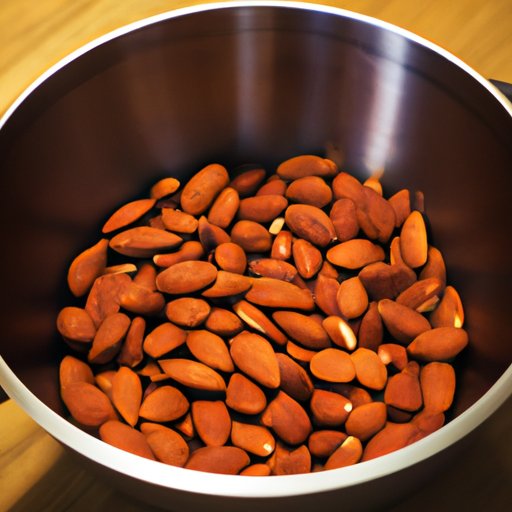I. Introduction
Roasted almonds are a popular snack or ingredient that has been around for centuries. They are not only a delicious treat but also packed with nutrients. If you’re looking to make them at home, this article will guide you through the process. We will discuss the best methods for roasting almonds, tips and tricks to achieve perfect results every time, and some flavor variations to spice them up.
II. A Step-by-Step Guide to Roasting Almonds in the Oven
To start, it is important to select raw, unroasted almonds. Preheat your oven to 350°F (180°C), and line a baking sheet with parchment paper. Spread the almonds on the baking sheet in a single layer. Roast them in the oven for 10-15 minutes, stirring every 5 minutes. The almonds are ready when they turn golden brown and have a toasted aroma. Be careful not to overcook them, or they will taste bitter.
III. The Benefits of Roasting Almonds and How to Do It Right
Roasting almonds enhances their flavor and changes their texture. They become crunchy, nutty, and fragrant. The low heat and slow roasting process are essential to avoid burning the almonds. You can season the almonds with salt, spices, or even sugar for a sweet version. To add flavor, you can coat the almonds with oil or syrup before roasting.
IV. How to Make Flavored Roasted Almonds at Home
Why not experiment with different flavors to give your almonds a unique twist? For example, you can make honey roasted almonds by mixing honey, cinnamon, and sea salt in a bowl. Add the almonds and stir until they are well coated. Spread them on a baking sheet and roast for 10-15 minutes in the oven. Or, make rosemary garlic almonds by adding minced garlic, chopped rosemary, and olive oil to the almonds before roasting them.
V. Quick and Easy Stovetop Method for Roasting Almonds
Another option for roasting almonds is to use a stovetop skillet. Heat the skillet over medium heat and add the almonds. Stir them continuously for 5-10 minutes until they are golden brown. Be sure not to leave them unattended, or they could burn.
VI. The Dos and Don’ts of Roasting Almonds in a Microwave
If you’re short on time, you can also try roasting almonds in the microwave. However, it can be tricky and requires special attention. Place the almonds in a microwave-safe bowl and microwave them for 1 minute at a time, stirring between each interval. Keep a close eye on them and don’t hesitate to stop if they start to burn or smoke. Microwave ovens vary, so it may take several attempts to find the right time and power settings.
VII. A Beginner’s Guide to Roasting Almonds Like a Pro
To roast almonds like a pro, follow these tips: use raw, unroasted almonds, avoid overcrowding the baking sheet, stir the almonds frequently, and don’t overcook them. Roasting almonds is a simple process that requires a bit of patience and attention to detail.
VIII. The Perfect Recipe for Homemade Cinnamon Roasted Almonds
If you’re looking for a classic flavor, try making homemade cinnamon roasted almonds. Here’s what you’ll need:
- 1 cup of raw almonds
- 1 tablespoon of honey
- 1 teaspoon of cinnamon
- 1/4 teaspoon of sea salt
Preheat your oven to 350°F (180°C), and line a baking sheet with parchment paper. Mix the honey, cinnamon, and salt in a bowl. Add the almonds and toss until they are evenly coated. Spread them on the baking sheet and roast for 10-15 minutes, stirring every 5 minutes. Let them cool for a few minutes before serving.
IX. Conclusion
Roasting almonds is an easy way to add flavor and texture to this healthy snack. Whether you choose to roast them in the oven, on the stovetop, or in the microwave, the key is to keep an eye on them and avoid burning them.
